Abstract
AIMS: To compare a histological hepatic iron index with a biochemical hepatic iron index, derived from atomic absorption spectroscopy measurements of hepatic iron content, for the diagnosis of genetic haemochromatosis (GH). METHODS: Histological sections of liver biopsy specimens from 70 subjects, who had previously had their biochemical hepatic iron index measured, were examined. The iron stores were scored to derive a histological hepatic iron index and were also graded from 0 to 4 by a standard grading system. The case history of each patient was then reviewed to establish a definitive clinical diagnosis and patients were classified as GH, non-GH or indeterminate. RESULTS: There were 26 cases of GH, 40 cases of non-GH and four indeterminate cases in whom a definite clinical diagnosis was not established. Using a biochemical hepatic iron index cut off level of 2.0, two cases were misclassified, with one case of GH having a biochemical hepatic iron index of 1.8 and one non-GH case having a biochemical hepatic iron index of 3.1. This could not have been improved by altering the cut off level. Using the recommended cut off level of 0.15, the histological hepatic iron index was raised in all cases of GH, but was also increased in 11 of the 40 non-GH patients. The specificity of this histological index can be improved by increasing the cut off level to 0.30. A histological iron grade of > or = 3 is more specific than the histological index but has a lower sensitivity, which particularly affects the diagnosis of younger patients with GH. CONCLUSIONS: The biochemical hepatic iron index is a reliable method for establishing a diagnosis of homozygous GH. In contrast, the histological hepatic iron index as originally described is non-specific and does not reliably distinguish patients with GH from others with a raised hepatic iron index due to other causes. The specificity of this index can be improved by increasing the cut off level used, but the discrimination provided by the histological index is still inferior to that provided by the biochemical hepatic iron index.
Full text
PDF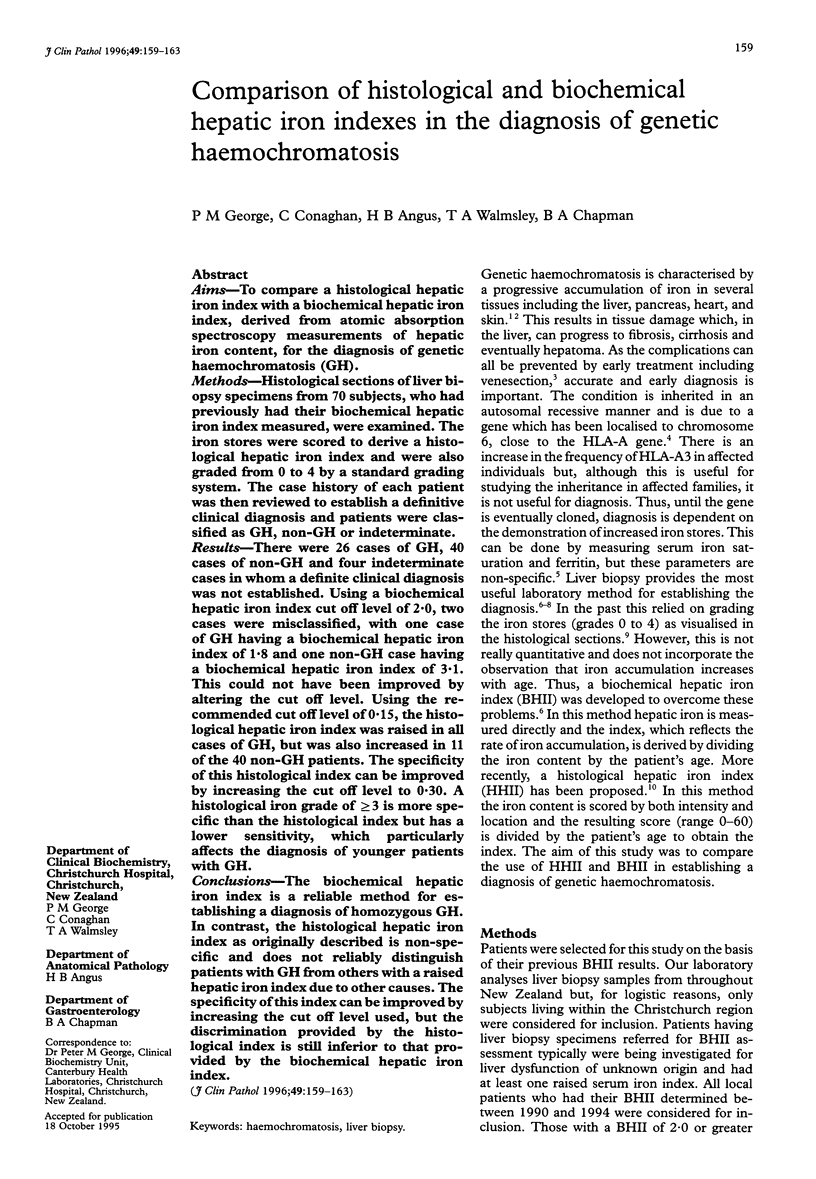
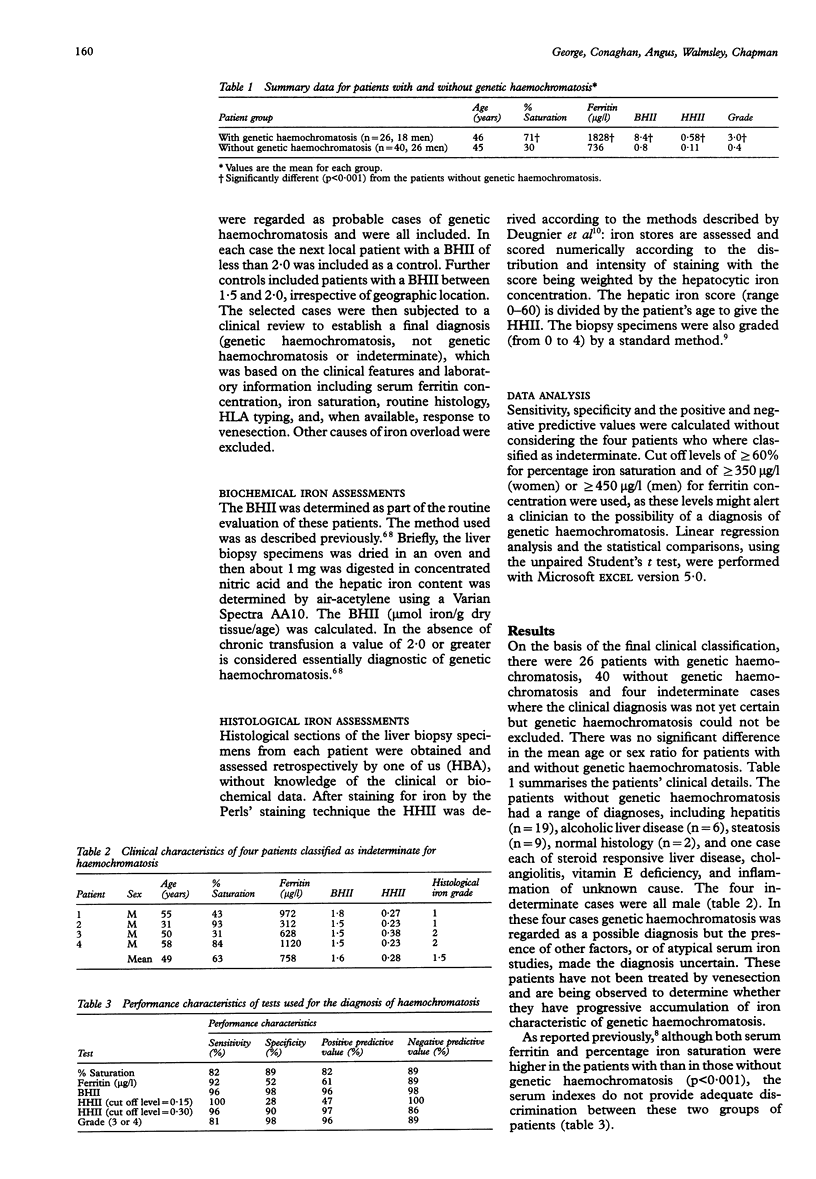
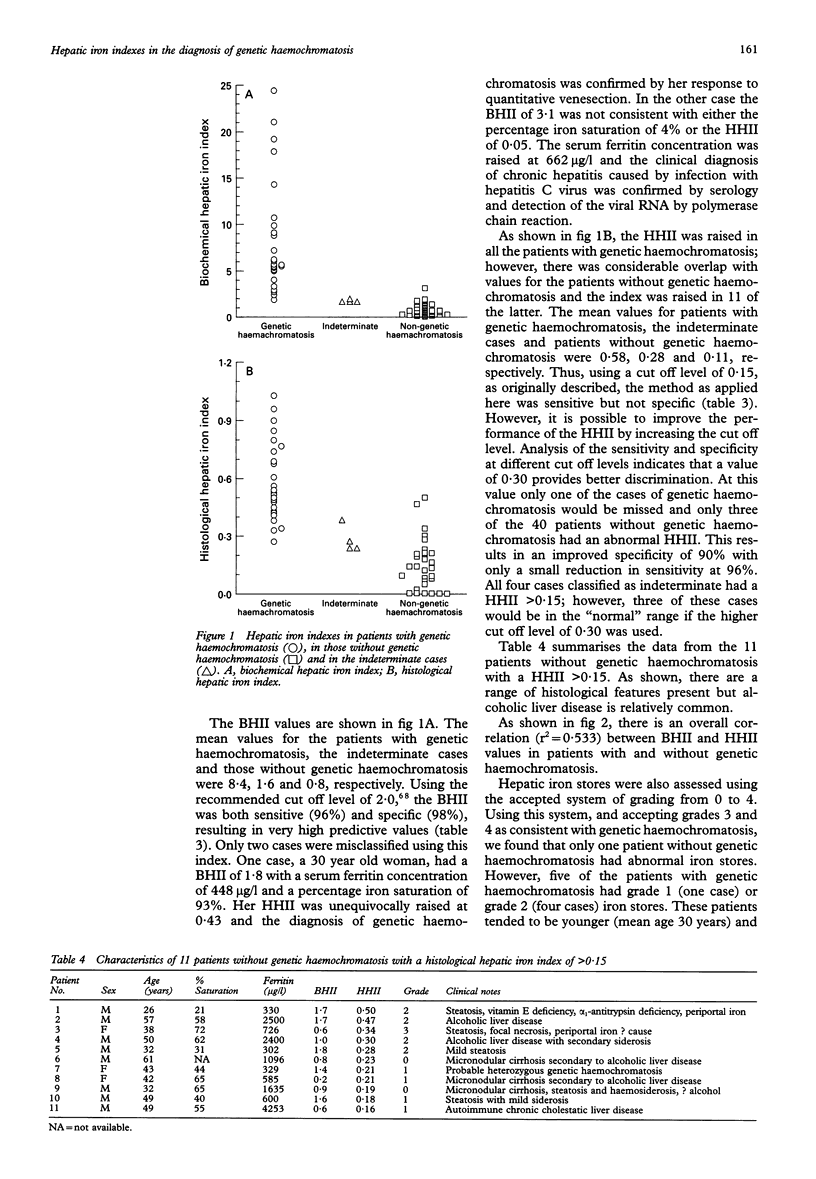
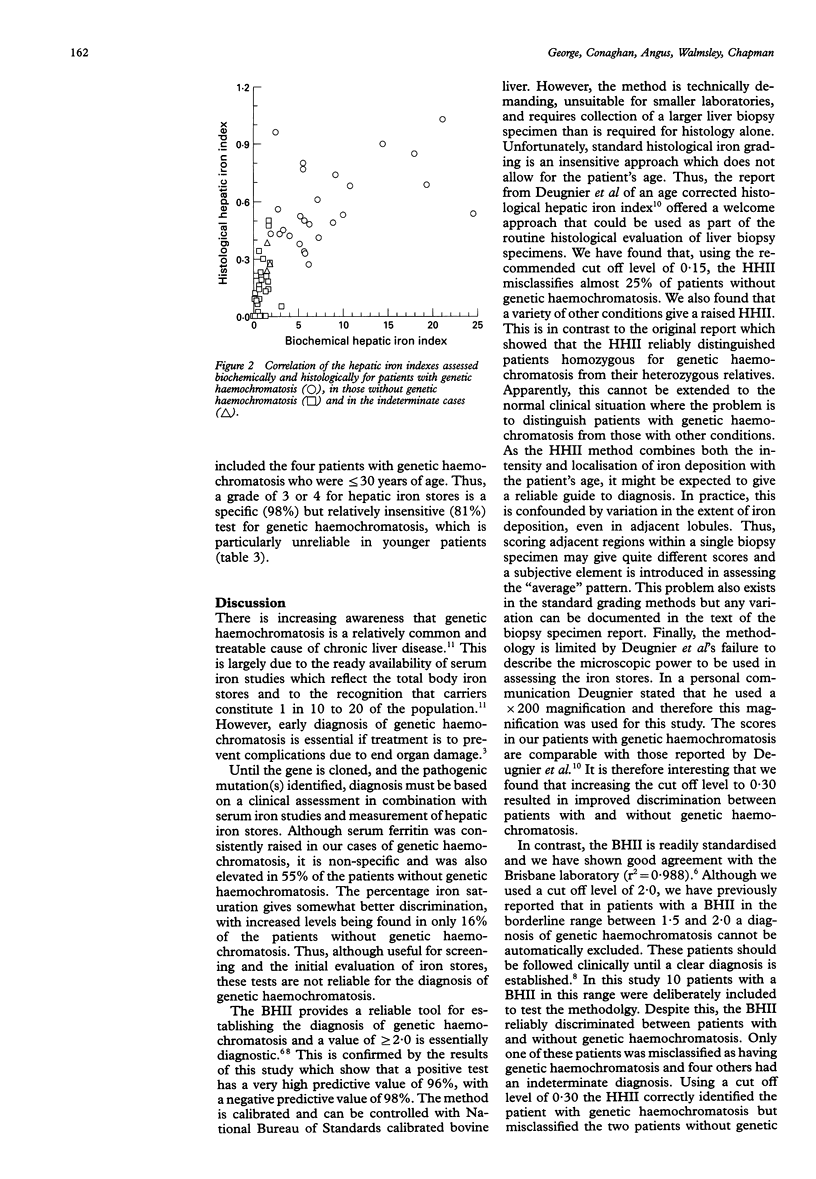
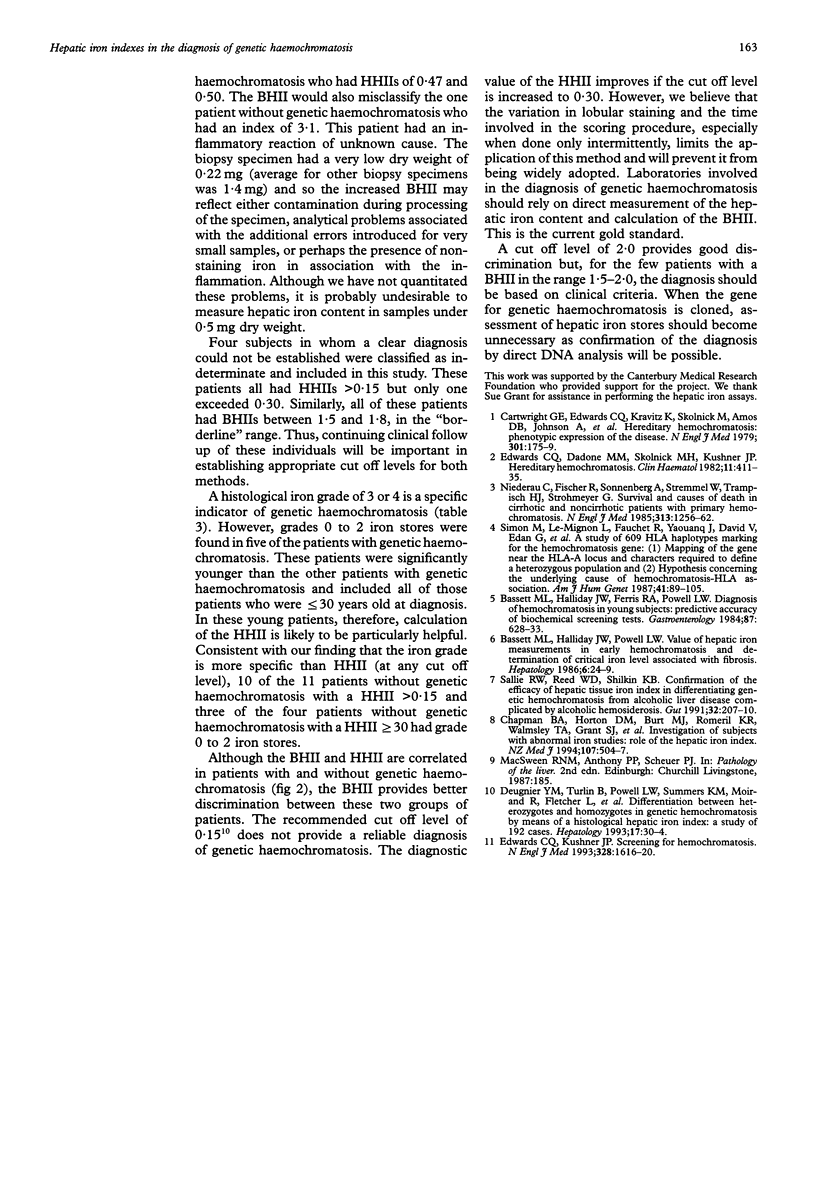
Selected References
These references are in PubMed. This may not be the complete list of references from this article.
- Bassett M. L., Halliday J. W., Ferris R. A., Powell L. W. Diagnosis of hemochromatosis in young subjects: predictive accuracy of biochemical screening tests. Gastroenterology. 1984 Sep;87(3):628–633. [PubMed] [Google Scholar]
- Bassett M. L., Halliday J. W., Powell L. W. Value of hepatic iron measurements in early hemochromatosis and determination of the critical iron level associated with fibrosis. Hepatology. 1986 Jan-Feb;6(1):24–29. doi: 10.1002/hep.1840060106. [DOI] [PubMed] [Google Scholar]
- Cartwright G. E., Edwards C. Q., Kravitz K., Skolnick M., Amos D. B., Johnson A., Buskjaer L. Hereditary hemochromatosis. Phenotypic expression of the disease. N Engl J Med. 1979 Jul 26;301(4):175–179. doi: 10.1056/NEJM197907263010402. [DOI] [PubMed] [Google Scholar]
- Chapman B. A., Horton D. M., Burt M. J., Romeril K. R., Walmsley T. A., Grant S. J., George P. Investigation of subjects with abnormal iron studies: role of the hepatic iron index. N Z Med J. 1994 Dec 14;107(991):504–507. [PubMed] [Google Scholar]
- Deugnier Y. M., Turlin B., Powell L. W., Summers K. M., Moirand R., Fletcher L., Loréal O., Brissot P., Halliday J. W. Differentiation between heterozygotes and homozygotes in genetic hemochromatosis by means of a histological hepatic iron index: a study of 192 cases. Hepatology. 1993 Jan;17(1):30–34. [PubMed] [Google Scholar]
- Edwards C. Q., Kushner J. P. Screening for hemochromatosis. N Engl J Med. 1993 Jun 3;328(22):1616–1620. doi: 10.1056/NEJM199306033282208. [DOI] [PubMed] [Google Scholar]
- Niederau C., Fischer R., Sonnenberg A., Stremmel W., Trampisch H. J., Strohmeyer G. Survival and causes of death in cirrhotic and in noncirrhotic patients with primary hemochromatosis. N Engl J Med. 1985 Nov 14;313(20):1256–1262. doi: 10.1056/NEJM198511143132004. [DOI] [PubMed] [Google Scholar]
- Simon M., Le Mignon L., Fauchet R., Yaouanq J., David V., Edan G., Bourel M. A study of 609 HLA haplotypes marking for the hemochromatosis gene: (1) mapping of the gene near the HLA-A locus and characters required to define a heterozygous population and (2) hypothesis concerning the underlying cause of hemochromatosis-HLA association. Am J Hum Genet. 1987 Aug;41(2):89–105. [PMC free article] [PubMed] [Google Scholar]


